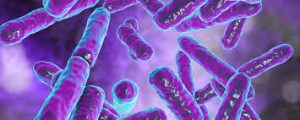 Bifidobacterium is a genus of gram-positive, nonmotile, often branched anaerobic bacteria.
Bifidobacterium is a genus of gram-positive, nonmotile, often branched anaerobic bacteria.
They are ubiquitous inhabitants of the gastrointestinal tract though strains have been isolated from the vagina and mouth.
Bifidobacteria are one of the major genera of bacteria that make up the gastrointestinal tract microbiota.
Some bifidobacteria are used as probiotics.
The genus Bifidobacterium possesses a unique fructose-6-phosphate phosphoketolase pathway employed to ferment carbohydrates.
Much metabolic research on bifidobacteria has focused on oligosaccharide metabolism, as these carbohydrates are available in their otherwise nutrient-limited habitats.
Infant-associated bifidobacterial phylotypes appear to have evolved the ability to ferment milk oligosaccharides.
Adult-associated species use plant oligosaccharides, consistent with what they encounter in their respective environments.
Breast-fed infants often harbor bifidobacteria-dominated gut consortia.
The sensitivity of members of the genus Bifidobacterium to O2 generally limits probiotic activity to anaerobic habitats.
Low concentrations of O2 and CO2 can have a stimulatory effect on the growth of some Bifidobacterium strains.
13.7% of the identified bifidobacterial genes encode enzymes involved in carbohydrate metabolism.
Adding Bifidobacterium as a probiotic to conventional treatment of ulcerative colitis has been shown to be associated with improved rates of remission and improved maintenance of remission.
Some Bifidobacterium strains are important probiotics and used in the food industry.
Different species and/or strains of bifidobacteria exert a range of beneficial health effects: including the regulation of intestinal microbial homeostasis, the inhibition of pathogens and harmful bacteria that colonize and/or infect the gut mucosa, the modulation of local and systemic immune responses, the repression of procarcinogenic enzymatic activities within the microbiota, the production of vitamins, and the bioconversion of a number of dietary compounds into bioactive molecules.
Bifidobacteria improve the gut mucosal barrier and lower levels of lipopolysaccharide in the intestine.
Bifidobacteria may also improve abdominal pain in patients with irritable bowel syndrome (IBS), but studies been inconclusive.
Naturally occurring Bifidobacterium spp. may discourage the growth of Gram-negative pathogens in infants.
An infant reaches the adult stage of their microbiome at around three years of age, when their microbiome diversity increases, stabilizes, and the infant switches over to solid foods.
Breast-fed infants are colonized earlier by Bifidobacterium when compared to babies that are primarily formula-fed.
Bifidobacterium is the most common bacteria in the infant gut microbiome.
Infants and children under three years old show low diversity in microbiome bacteria, but more diversity between individuals when compared to adults.
Reduction of Bifidobacterium and increase in diversity of the infant gut microbiome occurs with less breast-milk intake and increase of solid food intake.
Mammalian milk all contain oligosaccharides are not digested by enzymes and remain whole through the digestive tract before being broken down in the colon by microbiota.
Bifidobacterium species genomes of B. longum, B. bifidum, B. breve contain genes that can hydrolyze some of the human milk oligosaccharides and these are found in higher numbers in infants that are breast-fed.
